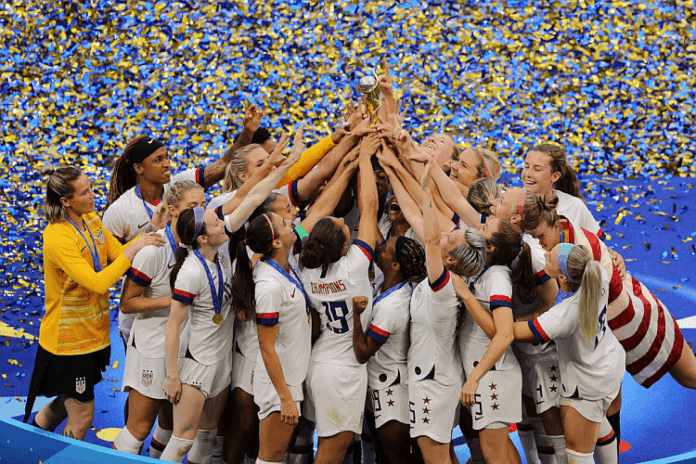After developments on Monday and Tuesday, the U.S. women’s World Cup victory in France just 23 days ago already seems far behind in the past. And that’s before the team will play its first “Victory Tour” game this Saturday at the Rose Bowl in Pasadena, California against Ireland.
On Tuesday, the U.S. Soccer Federation announced that Jill Ellis, 52, will step down as head coach of the USWNT at the end of October, following the conclusion of its Victory Tour matches. She compiled a gaudy 102-7-18 record so far – that’s an 87.4% winning percentage – since she started in May of 2014.
“When I accepted the head coaching position this was the timeframe I envisioned,” Ellis said. “The timing is right to move on and the program is positioned to remain at the pinnacle of women’s soccer. Change is something I have always embraced in my life and for me and my family this is the right moment.”
This comes a day after USSF President Carlos Cordeiro posted an open letter in which he noted that the U.S. women’s team had been paid more than the men’s team members over the last 10 years. The accompanying fact sheet noted:
● “From 2010 through 2018, U.S. Soccer paid our women $34.1 million in salaries and game bonuses and we paid our men $26.4 million—not counting the significant additional value of various benefits that our women’s players receive but which our men do not.”
● The members of the USWNT receive a salary of $100,000 a year for being on the team and those that play in the National Women’s Soccer League (NWSL) received additional salaries of $67,500-72,500: that $167,500-172.500 to start and “atop which they can earn game and tournament bonuses.”
● “Above and beyond the guaranteed salaries mentioned above, U.S. Soccer provides our women players with a robust package of benefits that are not provided to the men. These benefits include fully-paid health, dental and vision insurance; severance; a 401(k) retirement plan; paid maternity leave; guaranteed injury protection; and assistance with childcare.”
● What about the members of the men’s team? “[A]lthough players on our Men’s National Team can earn larger bonuses, they are guaranteed nothing; they have a different contract structure.”
Some of this could be inferred from examining the USSF’s Form 990 tax returns filed with the Internal Revenue Service:
● For fiscal year 2015, the list of the top five independent contractors paid more than $100,000 by the USSF itself included four people, all of whom received $225,450: women’s team players Lauren Holiday, Meghan Klingenberg, Ali Krieger and Tobin Health.
● There were none in fiscal year 2016, but In 2017, the independent contractor list of $100,000+ payees included Christen Press ($257,920), Becky Sauerbrunn ($256,720), Kelly O’Hara ($256.695) and Sam Mewis ($247.497).
That puts the players listed among roughly the top 7% of all wage earners in the United States.
That is a good reason why the women agreed to mediation with USSF rather than going straight to trial on their claim of unequal pay vs. the men’s team, where they would have to prove actual discrimination as the basis for damages against the federation.
The USSF’s notes also included a refutation of the claim that the women earned more than the men in actual game revenues:
“From 2009 through 2019 — a timeframe that includes two Women’s World Cup championships—the Women’s National Team has earned gross revenue of $101.3 million over 238 games, for an average of $425,446 per game, and the Men’s National Team has earned gross revenue of $185.7 million over 191 games, for an average of $972,147 per game. More specifically, WNT games have generated a net profit (ticket revenues minus event expenses) in only two years (2016 and 2017). Across the entire 11-year period, WNT games generated a net loss of $27.5 million.”
None of this matters to the representatives of the women’s team, but World Cup superstar Megan Rapinoe signaled in an interview with The New York Times that equal pay isn’t the issue any more.
“We realize our worth now, and in the past we haven’t quite known what our market value is. If we get to the next round of collective bargaining agreement negotiations, which I think is in two years, and we’re not getting what we want, then we’re going to need to take more serious action than we’ve taken before and not settle for crap.”
So now, it’s pay us what we’re worth and not whatever the men get. That’s a whole new discussion, but to Rapinoe’s credit, she is talking about negotiations when a new agreement comes up (the current one ends in 2021) and playing under the current agreement – subject to whatever happens in mediation – until it concludes.
That discussion could go on for a while. The women’s team now has the 2020 Olympic cycle to go through, but then won’t play a meaningful game until late 2022 at the earliest. By then, the mediation may solve these issues for some years into the future, but less than a month after the celebration in France, the clouds are beginning to gather for U.S. women’s football.


























